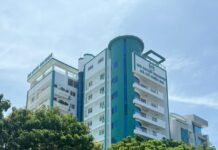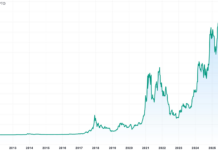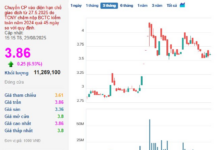Similar to other families who make a living by cage-farming fish in Hoa Binh Lake, Lo Thi Dao, an ethnic Thai woman with a family of five, relies on fishing and fish farming in the lake for their livelihood.
According to Ms. Dao, her family currently owns six fish cages, which generally provide a decent living for them all. “We go fishing every day, but our main income comes from fish farming. The average income is just over a hundred million VND per cage, excluding disease outbreaks. We recently lost all our fish to a disease and would like to expand our operation, but our financial situation doesn’t allow it.”
Mr. Nguyen Trung Nam, from Phuong Lam Ward in Hoa Binh City, is one of the individuals, businesses, and cooperatives with better conditions. He has invested in industrial-scale fish farming in Hoa Binh Lake, with 40 fish cages.

Cage fish farming combined with tourism on Hoa Binh Lake
Mr. Nam shared that the fish are usually ready for sale after about a year and a half of farming. Each cage can bring in a profit of 500 to 700 million VND after deducting expenses.
“Consistent feeding is crucial for successful fish farming,” Mr. Nam emphasized. “The locals face challenges, so they aren’t as efficient in fish care. Native fish species like ‘nganh’ and red-tailed ‘lang’ grow slowly but are less susceptible to diseases. Those fishing boats catch fish from the river and raise them for a few years, and the native fish are generally hardier and less prone to random deaths.”
Taking advantage of the natural advantages of Hoa Binh Lake, nearly 5,000 fish cages belong to households and businesses, with an average annual output of almost 10,000 tons. Most fish farming operations in Hoa Binh Lake focus on traditional fish species, resulting in relatively low yields and limited product competitiveness.

Fish farming on an industrial scale
Mr. Tran Hung Cuong, from the Hoa Binh Province Sub-Department of Fisheries, shared his insights on developing aquaculture in the lake area: “For fish to thrive, it starts with quality fingerlings. As a government agency, we guide fish cage operators to reliable fingerling suppliers to ensure the fish’s health and avoid inbreeding. We also advise farmers to maintain clean and well-ventilated cages and regularly remove excess feed and debris to prevent environmental pollution.”
Hoa Binh Lake, located in Hoa Binh City and four districts of Da Bac, Cao Phong, Tan Lac, and Mai Chau, boasts a pristine natural beauty often likened to Ha Long Bay on mountains.
Mr. Ha Van Cuong, Director of the Passion Hoa Binh Cooperative, one of the first to combine cage fish farming with tourism, shared that their cooperative has over a dozen members who have lived on Hoa Binh Lake for many years. They collaborate in cage fish farming, and each member earns an average annual income of over 100 million VND. The cooperative is also constructing floating houses to serve as restaurants and homestays for tourists.

Model of combining cage fish farming with the construction of floating houses for restaurants and homestays to serve tourists.
“The government is supportive, and we’re in the process of applying for a program that provides assistance with fingerlings, feed, and aquaculture techniques,” shared Mr. Cuong. “I believe that with this support, the lives of the people here will improve.”
In developing aquaculture, Hoa Binh Province focuses on implementing comprehensive solutions to leverage the potential and advantages of Hoa Binh Lake. This includes the urgent approval of a plan to develop aquaculture in Hoa Binh Lake in conjunction with tourism until 2030.
According to Mr. Luong Thanh Hai, Director of the Hoa Binh Province Sub-Department of Fisheries, the goal of developing fish cage culture is not solely about quantity. Controlling investments to prevent over-investment will ensure the lake’s environment is protected and the scenery preserved for tourism.

Developing aquaculture in Hoa Binh Lake involves implementing comprehensive solutions to leverage the potential and advantages of the lake.
“The Hoa Binh Provincial People’s Committee has tasked the Department of Agriculture and Rural Development and the Sub-Department of Fisheries with formulating a plan to develop fish farming in conjunction with tourism. This plan will focus on native and strong species like black and white ‘tram’ and native species like ‘lang’ and ‘chien.’ We will combine this with tourism experiences, allowing visitors to witness the care process and enjoy the very fish from the lake,” explained Mr. Hai.
The Hoa Binh Lake National Tourism Area, approved by the Prime Minister in 2016, provides a comprehensive development orientation for the area. The Hoa Binh Province is currently prioritizing infrastructure investments in concentrated fish cage farming areas on Hoa Binh Lake. They are also constructing high-tech fish farming models using environmentally friendly cage materials. Additionally, they are effectively organizing the aquaculture area in conjunction with tourism in the Hoa Binh Lake area.




































